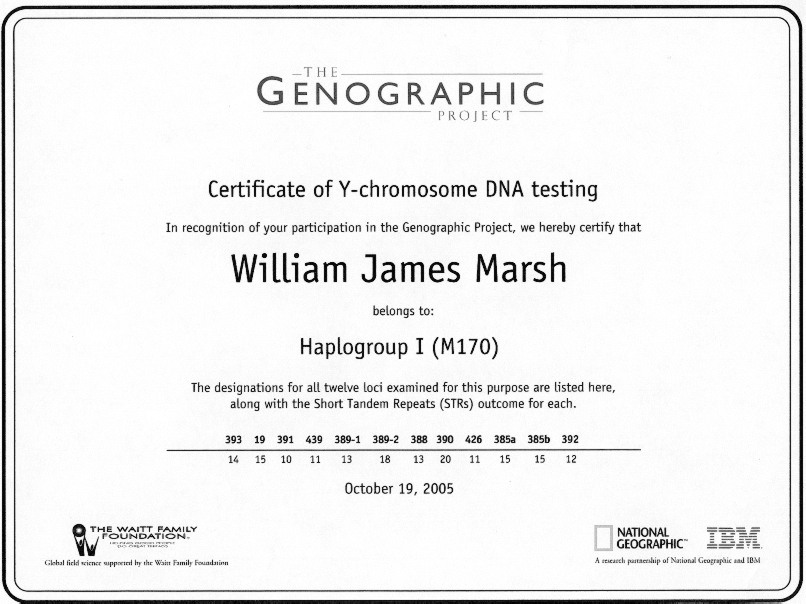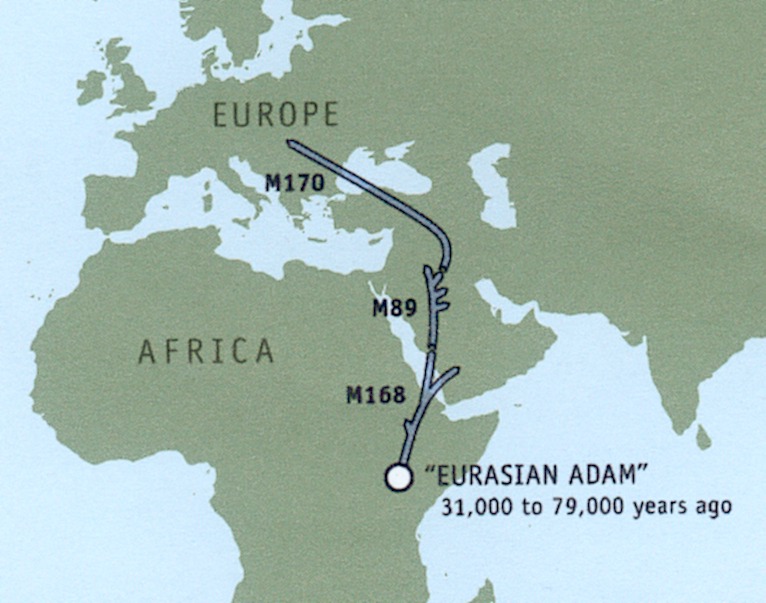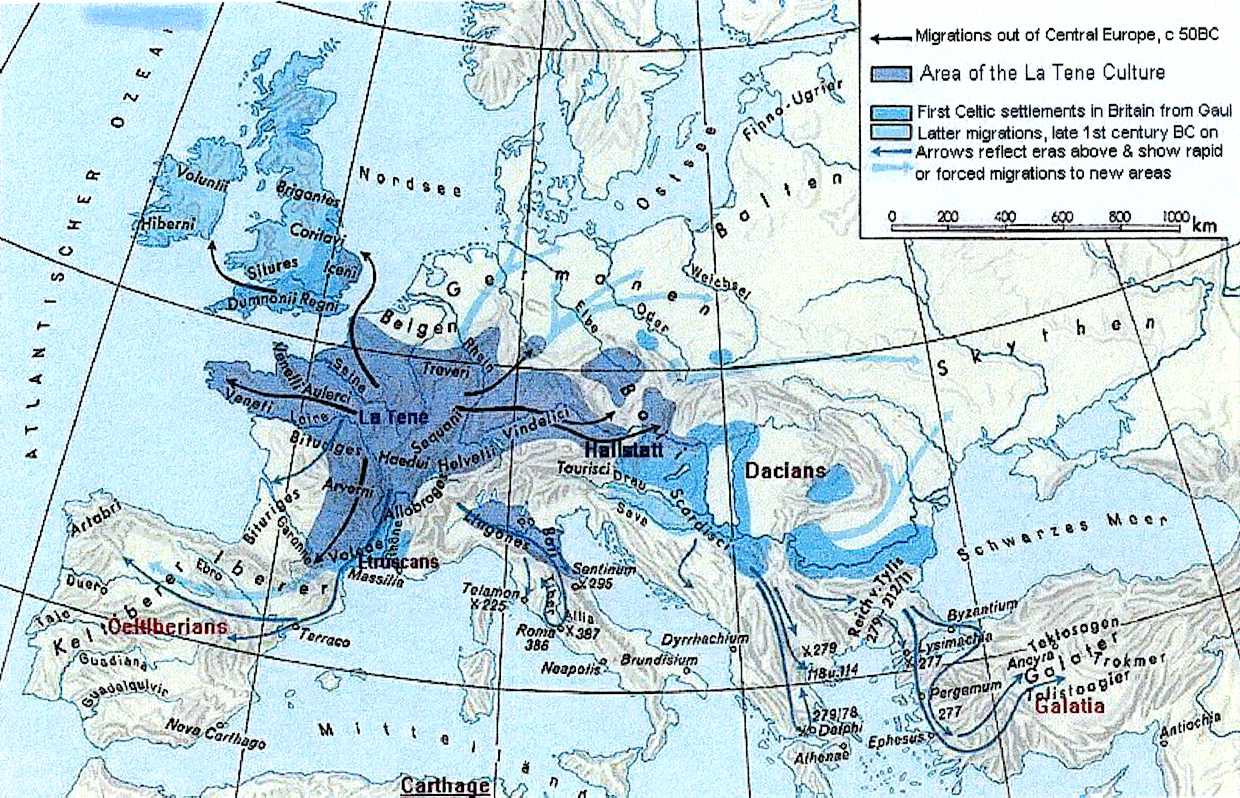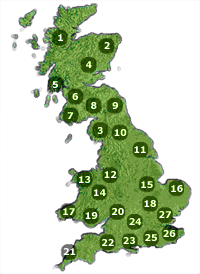|
|
|
Return
Home
To
My Results
To Some
UK Distant Cousins
To Some
European Distant Cousins
To FTDNA
Close Matches


GENETIC HISTORY: WILLIAM JAMES MARSH
HAPLOGROUP I (M170)
Your Y chromosome results identify you as a member of haplogroup I, a lineage defined by a genetic marker called M170. This haplogroup is the final destination of a genetic journey that began some 60,000 years ago with an ancient Y chromosome marker called M168.
The very widely dispersed M168 marker can be traced to a single individual-"Eurasian Adam." This African man, who lived some 31,000 to 79,000 years ago, is the common ancestor of every non-African person living today. His descendants migrated out of Africa and became the only lineage to survive away from humanity's home continent.
Population growth during the Upper Paleolithic era may have spurred the M168 lineage to seek new hunting grounds for the plains animals crucial to their survival. A period of moist and favorable climate had expanded the ranges of such animals at this time, so these nomadic peoples may have simply followed their food source.
Improved tools and rudimentary art appeared during this same epoch, suggesting significant mental and behavioral changes. These shifts may have been spurred by a genetic mutation that gave "Eurasian Adam's" descendants a cognitive advantage over other contemporary, but now extinct, human lineages.
Some 90 to 95 percent of all non-Africans are descendants of the second great human migration out of Africa, which is defined by the marker M89.
M89 first appeared 45,000 years ago in Northern Africa or the Middle East. It arose on the original lineage (M168) of "Eurasian Adam," and defines a large inland migration of hunters who followed expanding grasslands and plentiful game to the Middle East.
Many people of this lineage remained in the Middle East, but others continued their movement and followed the grasslands through Iran to the vast steppes of Central Asia. Herds of buffalo, antelope, woolly mammoths, and other game probably enticed them to explore new grasslands.
With much of Earth's water frozen in massive ice sheets, the era's vast steppes stretched from eastern France to Korea. The grassland hunters of the M89 lineage traveled both east and west along this steppe "superhighway" and eventually peopled much of the continent.
A group of M89 descendants moved north from the Middle East to Anatolia and the Balkans, trading familiar grasslands for forests and high country. Though their numbers were likely small, genetic traces of their journey are still found today.
Haplogroup I, is widespread throughout southeastern and central Europe and most common in the Balkans. Members of this haplogroup carry a 20,000-year-old marker dubbed M170.
This Y chromosome marker first appeared in the Middle East. Its subsequent spread into southeastern Europe may have accompanied the expansion of the prosperous Gravettian culture. These Upper Paleolithic people used effective communal hunting techniques and developed art notable for voluptuous female carvings often dubbed "Venus" figures.
The later spread of this lineage could also be tied to
the mid-first millenium B.C. Celtic culture. The tantalizing possibility
could explain the wider dispersal of this unique genetic marker.
_____________________________________________________________________________________________________________
Genographic has assigned me to the I haplogroup, which is a rather broad grouping of haplotypes. The I haplogroup is divided into sub-groups. My (William J Marsh) haplotype is thought to belong with a sub-group called I1c - I have yet to have my Y-DNA analysed specifically for the marker which would positively assign my membership to this sub-group.
I1c families are found thinly spread throughout Europe and thought to be associated with the early Gravettian cultures of central and western Europe mentioned by Genographic.
These folk were members of the small Upper Palaeolithic community of Europeans who later wintered in various refuges during the last glacial maximum.
The I1c Y-Clan is thought to have branched from I1* before the last glacial maximum and is accordingly also an Upper Palaeolithic community sub-group.
It has been put forward by Rootsi et al. [2005] that I1c may have wintered the last glacial maximum out in southern France. This area is well known as the winter refuge of the western Gravettian culture, whose stable diet was reindeer.
The possible migrations of the I1c Y-Clan from its refuge are shown in the map below.
The possibility exists, therefore,
that my Marsh line are descendants of these Celtic migrations.

The foregoing map and parts of the preceding text were extracted from the I1c Y-Clan Web site.
http://www.bbc.co.uk/history/ancient/prehistory/iron_01.shtml#top
Native Tribes of Britain

The British Isles and First Century AD tribal regions.
This map shows the approximate location of the major tribes who lived in Britain at the time of the Roman Conquest of Britain in the First Century AD.
Key Tribal Regions
01: Caledones (Caledonii) 02: Taexali 03:
Carveti i 04: Venicones 05: Epidii 06: Damnonii 07: Novantae 08: Selgovae
09: Votadini
10: Brigantes 11: Parisi 12: Cornovii 13: Deceangli 14:
Ordovoices 15: Corieltauvi 16: Iceni 17: Demetae 18: Catuvellauni
19: Silures 20: Dubunni 21: Dumnonii 22: Durotriges 23:
Belgae 24: Atrebates 25: Regni 26: Cantiaci 27: Trinovantes
The sole source for the existence and location of these tribes are Roman writers who visited Britain.
One of the best observers of the tribes of Celtic Britain was Tacitus who wrote on historical events in Britain. Another was a Roman geographer called Ptolemy who wrote a description of Britain, listing the names of the many British tribes.
However, we must treat these writings with care as they
are as much propaganda as impartial historical accounts. Furthermore, the
Roman writers sometimes misunderstood British events or even the names
of the tribes. This is especially true of their descriptions of tribes
in the north where Roman knowledge was even more limited. Indeed, precise
information about where these tribes lived is entirely absent from the
contemporary Roman records.
26: Cantiaci
This is the name of the tribe or people who lived in
north and east Kent. Like other peoples in southeast Britain at the time
of the Roman Conquest, this group was very open to influences from France
and the Mediterranean World and they eventually became part of the large
kingdom of Cunobelinus.
Like the Catuvellauni and Trinovantes they buried their dead according to the north French custom of cremation.
After the Roman Conquest they became a civitas based on their principle settlement at Canterbury.
For more information about the Cantiaci click:
Cantiaci
.